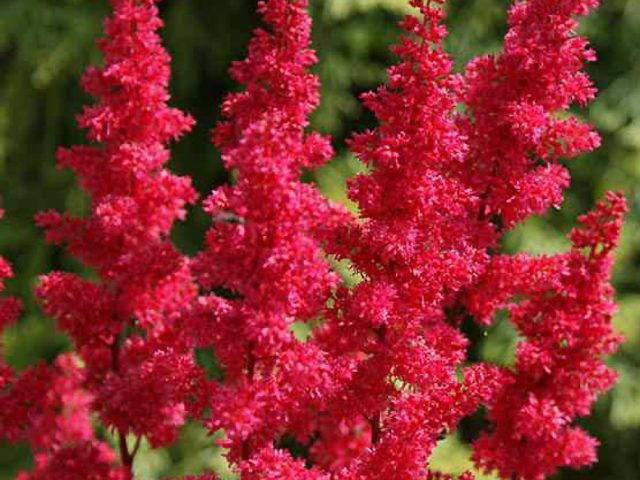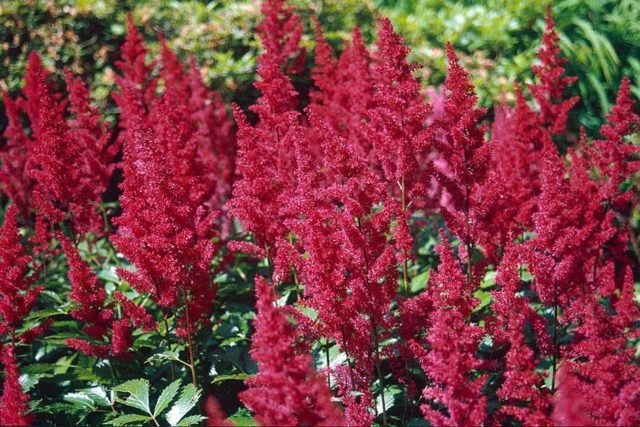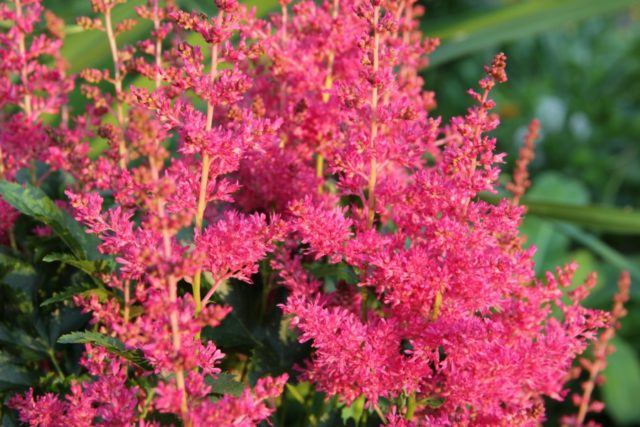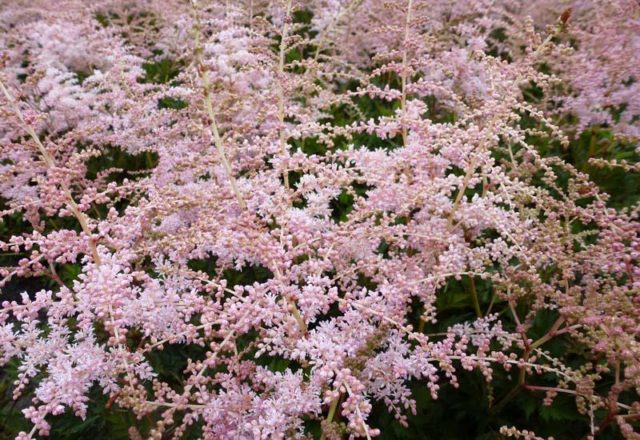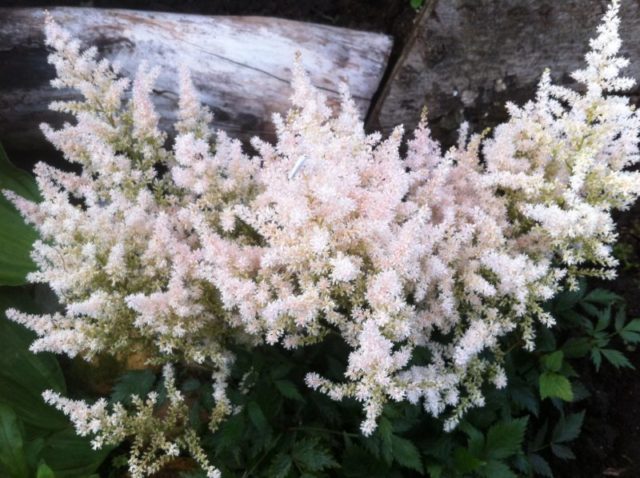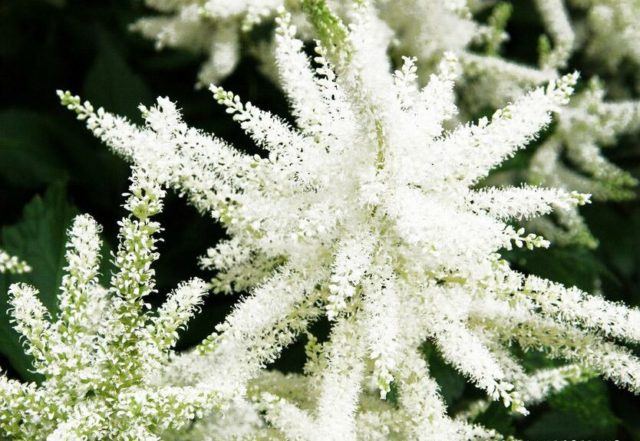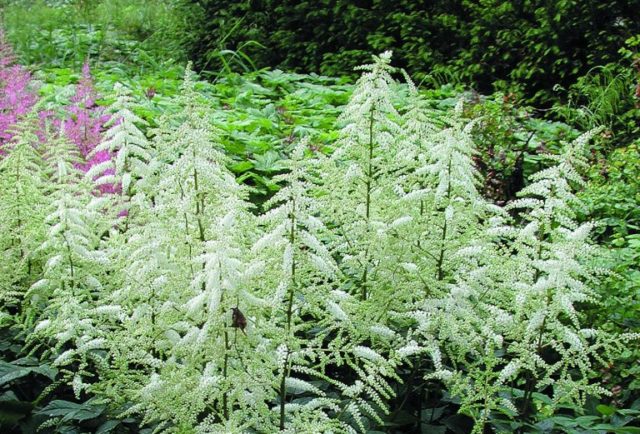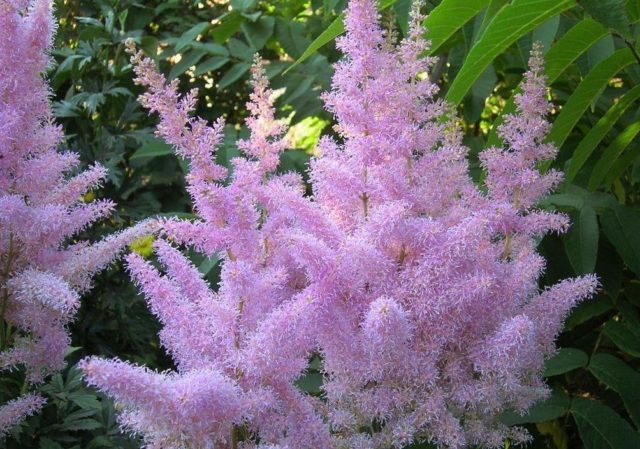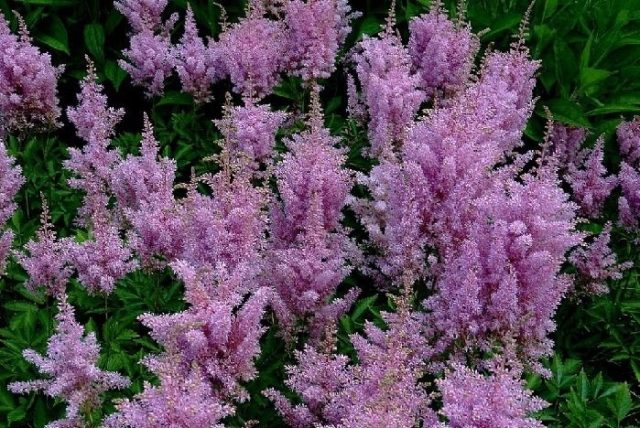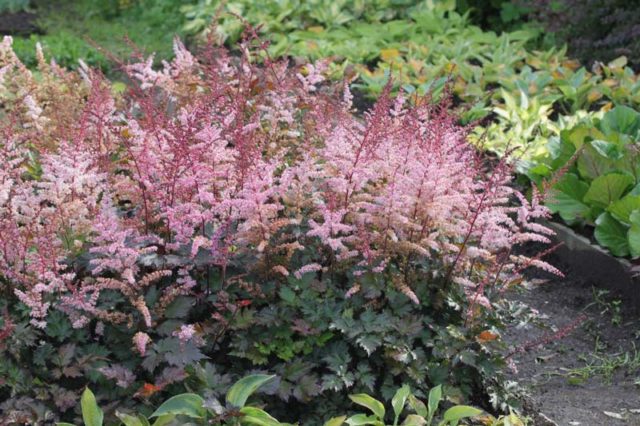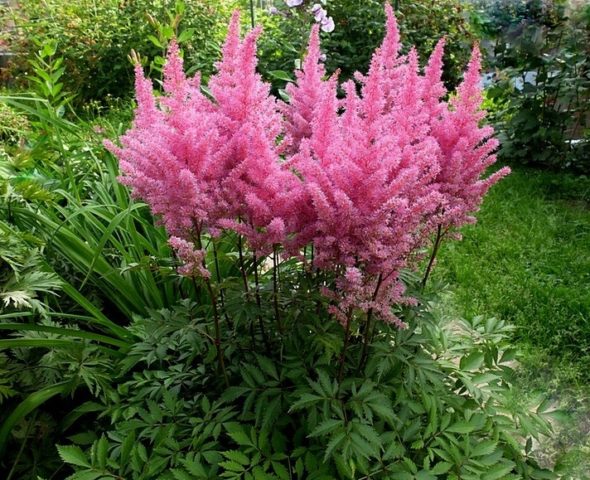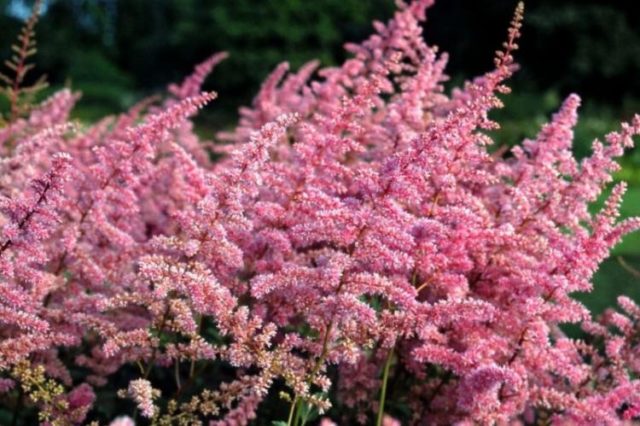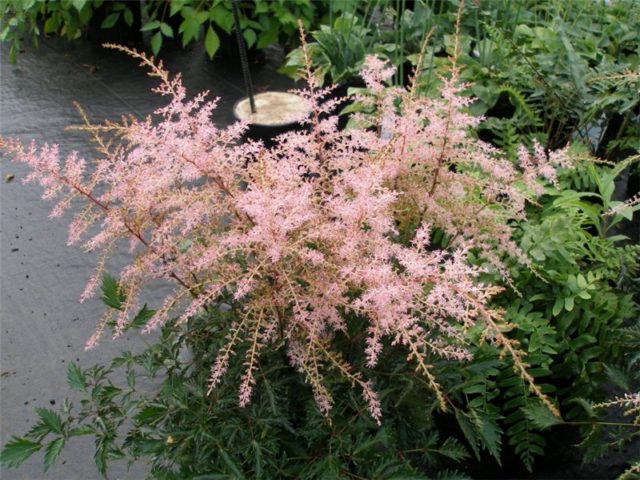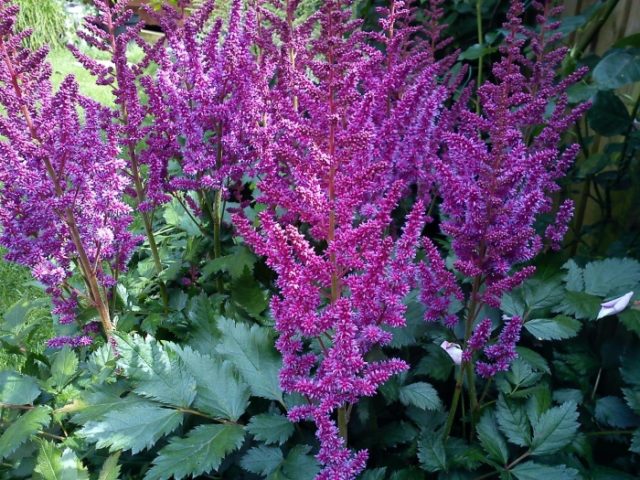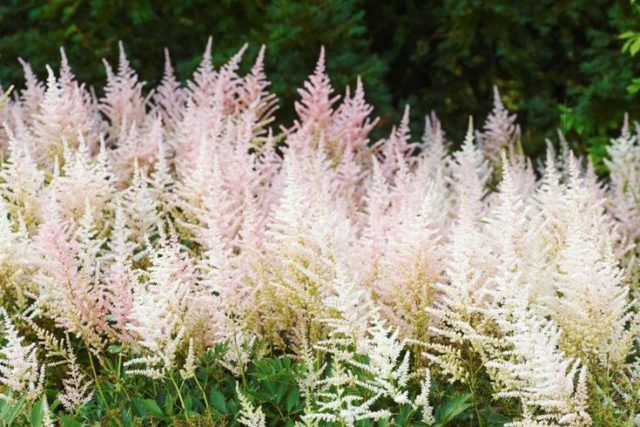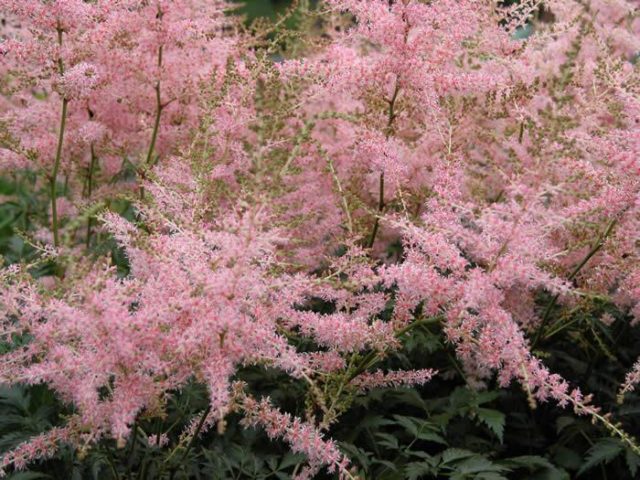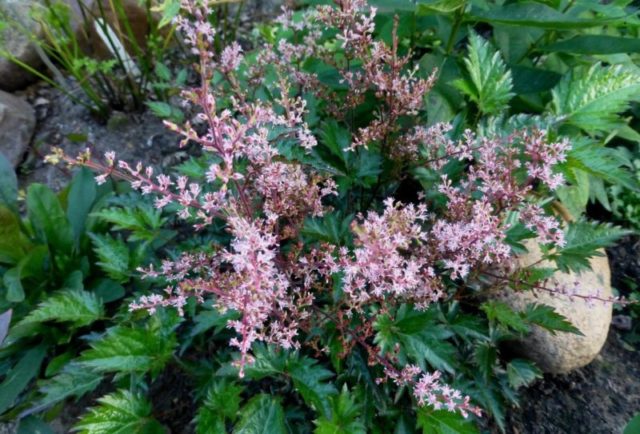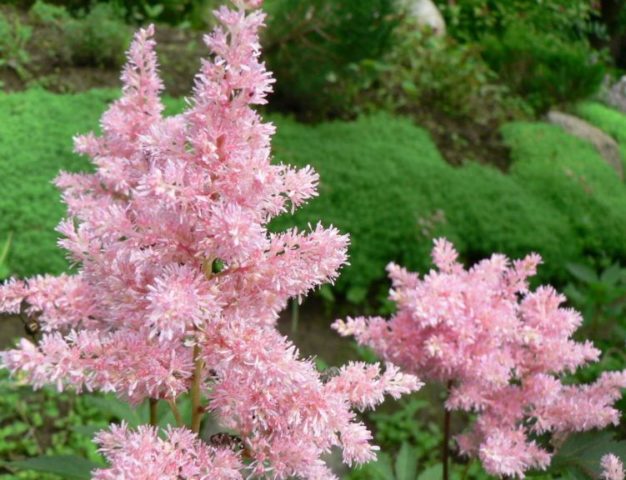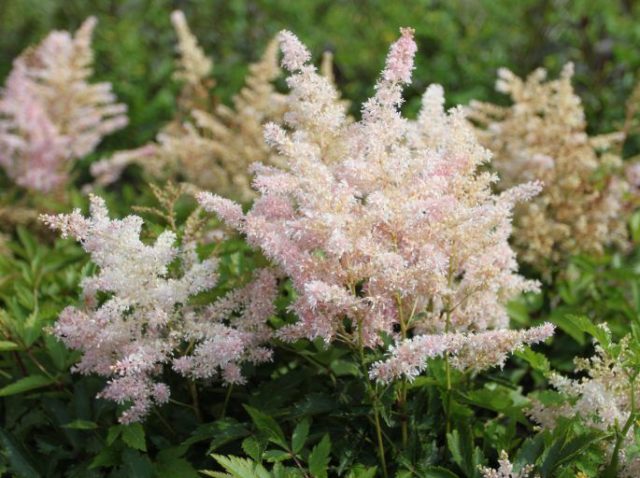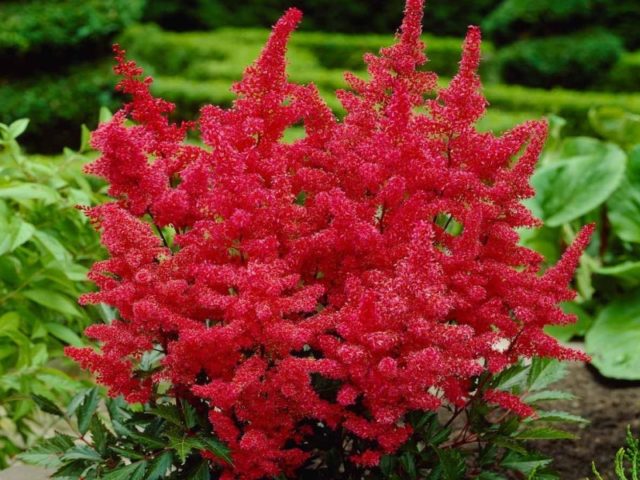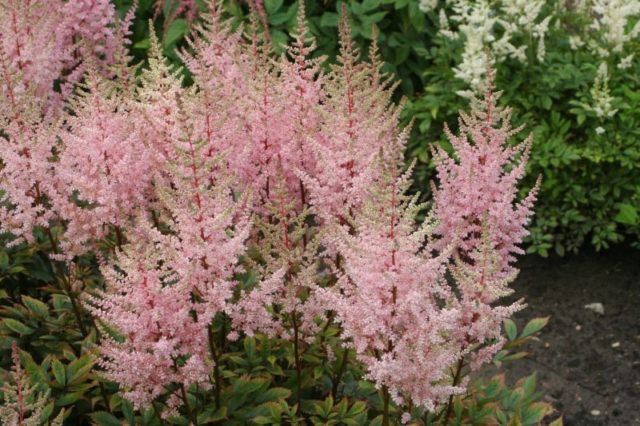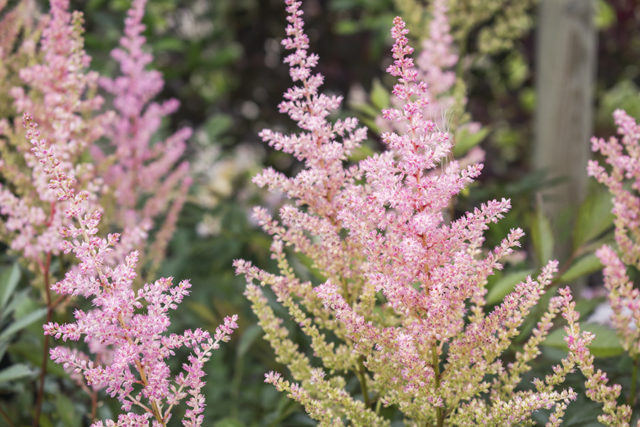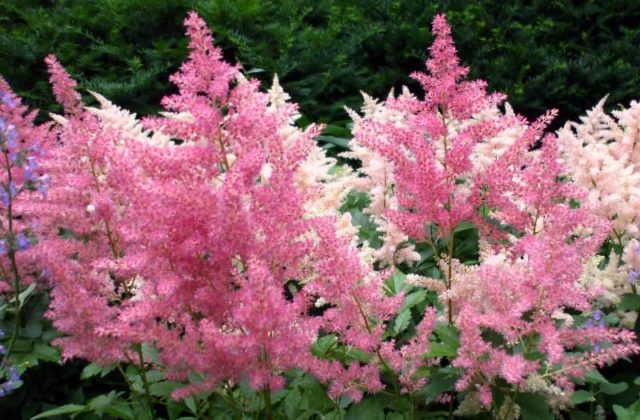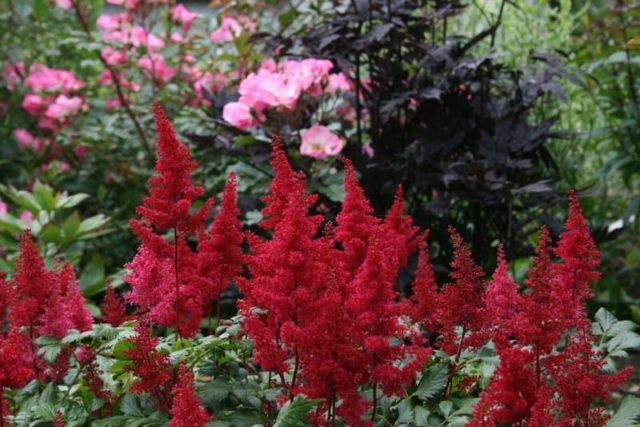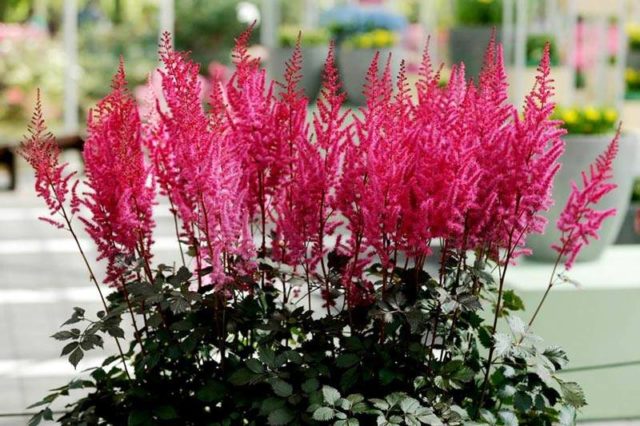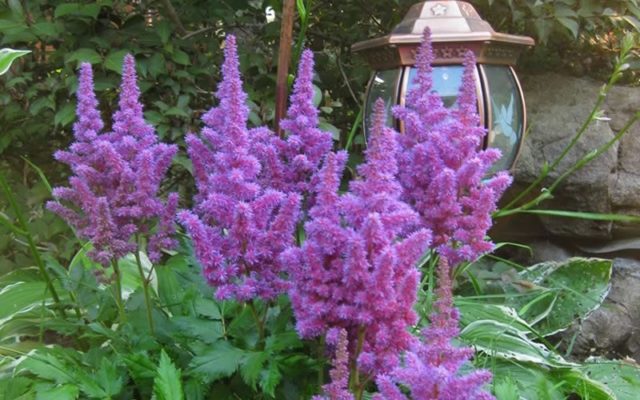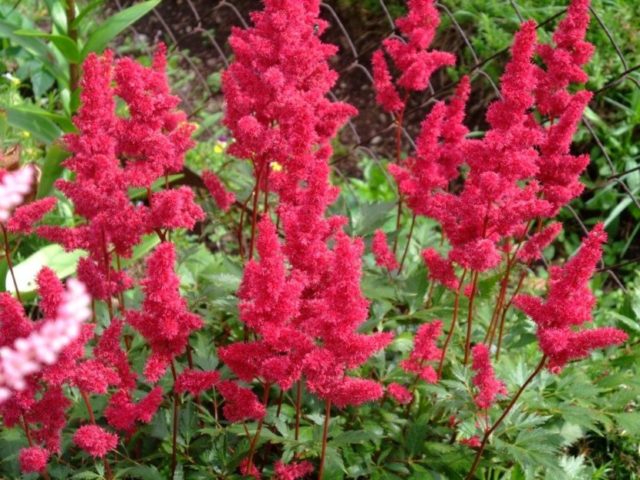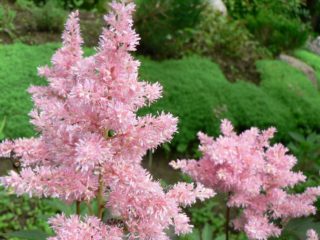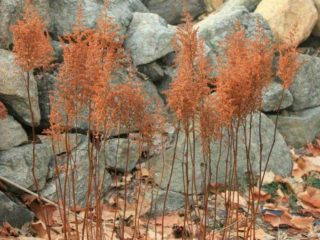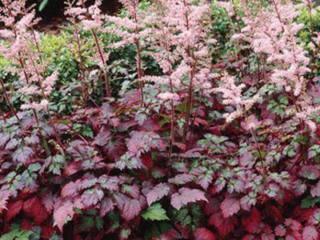Content
- 1 What are the astilbe
- 2 Types of astilba with photos and names
- 3 The best varieties of astilba
- 3.1 What colors are astilbe
- 3.2 Astilba varieties with unusual colored leaves
- 3.3 High grades of astilba
- 3.4 Medium-sized varieties of astilba
- 3.5 Dwarf astilba varieties
- 3.6 The best varieties of astilba by flowering time
- 3.7 Astilba varieties with a pleasant aroma
- 3.8 Astilba varieties for sunny places
- 3.9 Hybrid varieties of astilba
- 3.10 Astilba varieties for regions
- 3.11 New varieties of astilba
- 3.12 The most beautiful varieties of astilba
- 4 A few tips for choosing a variety
- 5 Conclusion
The varieties and types of astilba with photos and names should be studied by all keen growers. There are several hundred varieties of perennials in total, but the best ones can be distinguished in this variety.
What are the astilbe
Astilba is an extremely popular perennial in landscape design. To date, over 300 plant varieties have been bred.
First of all, it is customary to distinguish 8 main types, namely, astilbe:
- Japanese;
- Korean;
- Chinese;
- simple-leaved;
- naked;
- Thunberg;
- David;
- Arends.
All plants that can be bought in nurseries and shops are of one of these species or are hybrids.
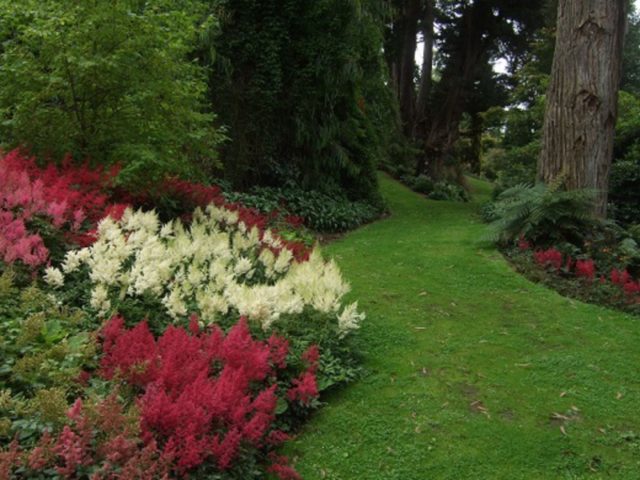
There are several classifications of the plant.
It is customary to classify astilbe according to other criteria:
- in height, from tall to dwarf;
- by flowering time, from June to the end of August;
- according to the type of inflorescences, they are pyramidal, paniculate, rhombic and drooping.
In order to successfully choose an astilba for a garden, you should familiarize yourself in more detail with all the varietal variety.
Types of astilba with photos and names
All Astilbe belong to one of the basic species or are derived from them. Due to this, there are common features between the individual varieties.
Chinese
A perennial plant of medium height can reach only about 60 cm. It prefers damp shaded places, brings flowers-panicles mostly pink, the leaves of the plant are green, bright. Flowering usually occurs in July or early August.
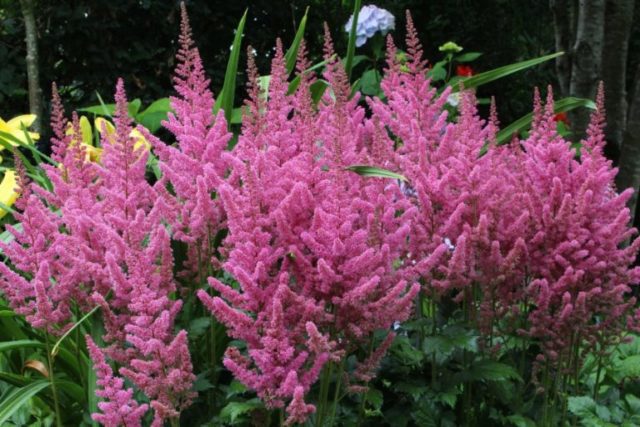
Chinese species - medium-sized plant
Astilba Thunberg
The species is quite rare. It is a medium-sized, rather tall perennial of about 80 cm with simple straight stems. The leaves of the species are standard pinnate, with denticles along the edges, green.
Astilba Thunberg blooms in white, lilac or pink shades, individual flowers are collected in lush brushes up to 25 cm long. The brushes can be up to 10 cm wide. The maximum decorative effect occurs towards the end of July.
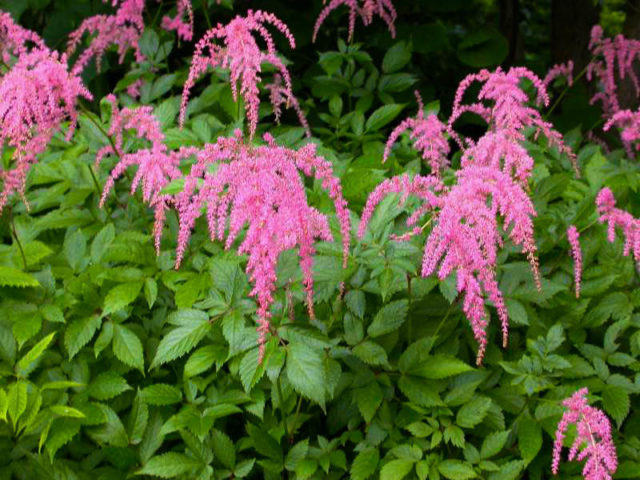
Astilba Thunberg - tall species with late flowering
Korean
The height is about 60 cm, the stem is covered with dark small hairs, the leaves are green, light. The flowering of the species is creamy white, inflorescences of a slightly drooping type about 25 cm long. Flowering begins in July and lasts 2-3 weeks.
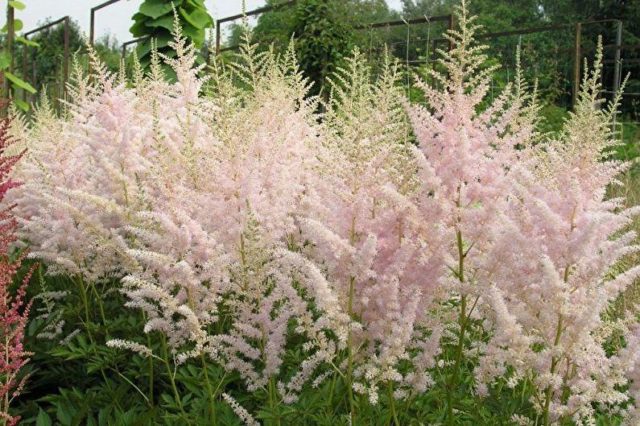
The Korean species blooms with creamy white drooping panicles
Naked
Naked, or smooth astilbe, is a short plant. Even with blossoming inflorescences, it usually rises no higher than 30 cm above the ground. Outside of flowering, the growth is only 12 cm. You can recognize the appearance by the dark green foliage and by the pale pink sparse panicles of the inflorescences.
It grows mainly in the shade and in high humidity, and blooms in July-August.

Naked astilba - undersized view of about 30 cm
Astilba Arends
This species is very popular in breeding; on its basis, many varieties and hybrids have been bred. Usually it is a medium-sized or tall perennial from 60 to 100 cm in height, with a spreading bush and feathery green leaves.
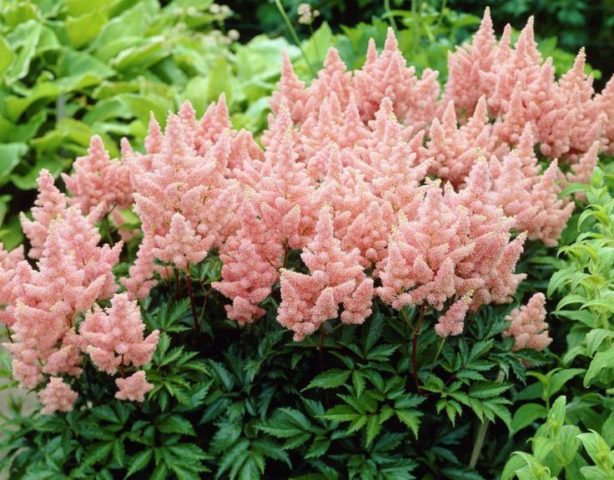
Astilba Arends is the most popular species in breeding
It blooms with thick fluffy brushes of all possible shades, depending on the particular plant. Apical inflorescences, lush, flowering falls in July-August.
Japanese
The species reaches about 60 cm in height and width. It has feathery leaves of a dark green hue, the leaves are shiny, the shade of the inflorescence depends on the variety and can be white, red or pink. The species blooms in July and August.
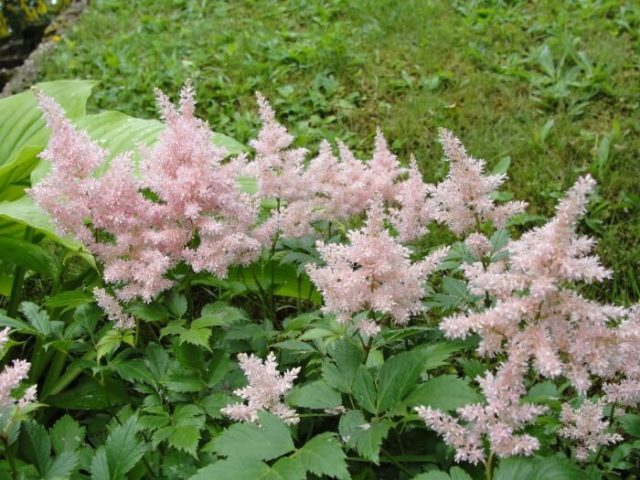
The Japanese species can bloom in any shade according to the variety.
Astilba David
Quite tall plant up to 1.5 in height, with a spreading bush and feathery leaves of light green color.
It blooms with small pink-lilac flowers, formed into pyramidal inflorescences up to 40 cm long. Flowering continues for about 2 weeks, and in terms of timing occurs in July and August.
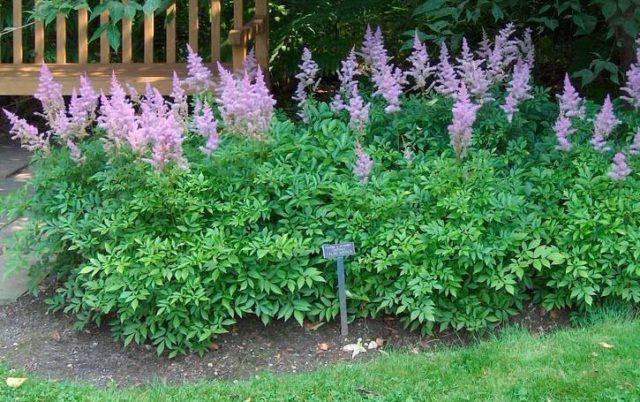
Astilba of David is not widespread, but it is used in breeding
Simple-leaved
Not very common, but valuable, it is a perennial plant with bright green, jagged leaf blades. In size, it reaches 50 cm in height and in diameter, blooms with dense panicles of a pyramidal or drooping shape, usually in August. It can be pink, white or red in color.
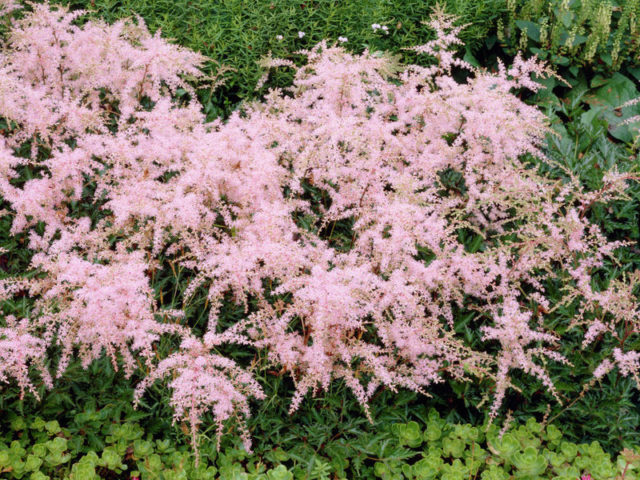
Plain look brings pyramidal or drooping brushes
The best varieties of astilba
The varietal diversity is very wide. The best varieties can be distinguished by color, flowering time and other characteristics.
What colors are astilbe
Astilbe can be roughly divided into color groups. Perennial brings inflorescences of white, red, purple, pink or lilac shades.
Red astilba varieties
Red varieties are popular because they look as impressive as possible on the site. Among the red astilbes, there are plants with bright red, crimson, crimson and purple blooms:
- Garnet... The fast-growing bush rises 80 cm above the ground, during the flowering period in July-August it gives purple-red pyramidal inflorescences. Leaves are deep green, inflorescences are dense and often spaced.
Pomegranate is a very intense red variety
- Vesuvius. The bush has an average height, up to 60 cm. During the flowering period in late July and early August, it gives dark red-burgundy paniculate inflorescences about 10 cm long. The foliage of the perennial is dark green.
Vesuvius is distinguished by a burgundy-red color
- Unique Ruby Red. It belongs to the category of low, the stems rise by about 50 cm. The leaves are dark green throughout the season, flowering takes place starting in July, Unic Ruby Red gives red dense inflorescences.
Unique Ruby Red brings red flowers with a raspberry hue
Varieties of pink astilba
Pink plants are suitable for the formation of flower beds in soft and delicate colors. They go well with other light perennials, but they can also act as an accent spot on a dark background:
- Pink Lightning. The plant belongs to the category of undersized and usually does not exceed 40 cm in height. The leaves are green with a slight bronze tint, the drooping inflorescences are light pink, and the variety blooms in August.
Pink Lightning has a delicate pink bloom
- Straussenfeder. A medium-sized perennial up to 80 cm tall has large dark green leaves and coral-pink inflorescences of a drooping type. Blooms in late periods, closer to August.
Straussenfeder has a beautiful coral pink color
Pink plants prefer shaded areas, but tolerate sunlight better than darker varieties.
Astilba varieties with white flowers
White astilbe is a frequent choice of gardeners. Among the most common are:
- White Wings;
WhiteWings is a white variety with a slightly noticeable shade of pink
- Washington;
Washington is a pure white variety
- Deutschland.
Deutschland is a popular white variety
The requirements for white bushes are the same as for others - plants prefer shade and moisture.
Astilba varieties with lilac and purple inflorescences
An interesting decorative option for decorating a site is lilac or purple astilbe. Depending on the shade, the plant can act as a light or dark accent in an artistic composition:
- America. In its adult form, it reaches 80 cm in height, the bush is quite sprawling. The leaves are green, with carved edges, the inflorescences are panicles of a pale lilac color. Flowering lasts 2-4 weeks and occurs from the end of July.
America is a popular lilac species
- Siegfried. In height, it rises 60-90 cm above the ground, has a brown-green feathery foliage. Paniculate inflorescences, medium density, purple-violet in shade. Flowering occurs from mid-July.
Siegfried - a view with a purple tint
When planting, lilac and purple bushes can be combined with each other, making up interesting compositions.
Is there blue and blue astilbe
Sometimes on the Internet you can find photographs of blue or bright blue astilbe. However, in this case we are talking about color processing. In reality, the plant does not give blue and blue colors, even purple varieties are much closer to red.
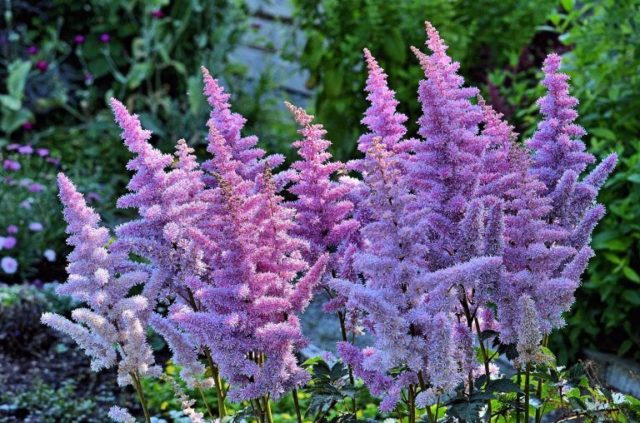
Blue and bright blue astilbe - the result of photo processing
Astilba varieties with unusual colored leaves
Some plants are valued not only for their beautiful flowering, but also for the decorative coloring of the leaves:
- Deft Lace. In July, the variety up to 80 cm in height gives pyramidal inflorescences with a pink tint. But Deft Lays is valued for the color of the leaves, in spring their color is purple, in summer they turn bright green, and by autumn they change color to slightly bluish.
Even at the beginning of summer, a burgundy hue is still noticeable on the leaves of Deft Lays.
- Color Flash Lime. The plant, which grows up to 60 cm, has erect pink inflorescences, but also differs in unusual leaves. In the spring they are yellow, and in the summer they turn light green, with a golden tint and reddish edges.
Color Flash Lime pleases the eye with golden-yellow-green foliage
High grades of astilba
Tall bushes are often used to form the background of flower beds. Astilbes are considered high, which rise above the ground by 90 cm and higher:
- Red Charm. The perennial is 100 cm in height or more, has green shiny leaves. The flowering of the variety is red with a slight pink tinge, slightly drooping, begins in July and lasts about a month.
Red Charm exceeds a meter in height
- Rose Perle. During the flowering period, the plant rises to 90 cm and more, brings lush pale pink panicles of a drooping type in July. In spring, the bush is distinguished by especially bright, light green decorative leaves.
Rose Perle rises above 90 cm
Medium-sized varieties of astilba
Perennials of medium height rise 50-80 cm above the ground. They are used to decorate flower beds and flower beds, to create the front background of a hedge:
- Gloria Purpurea. In height, the plant rises 70 cm, it is distinguished by dark leaves and voluminous rhombic inflorescences. The flowering of the variety is raspberry-pink, lush and dense, and astilbe blooms in June.
Gloria Purpurea is a medium-sized variety
- Cattleya. It rises 80 cm from the ground, blooms throughout the month with paniculate purple-pink inflorescences. The flowering period occurs at the end of July and lasts about 30 days. The leaves of the perennial are rich green.
Cattleya is a medium-tall pink perennial
Dwarf astilba varieties
Varieties not exceeding 50 cm are considered undersized.Among their variety, it is interesting to get acquainted with dwarf varieties:
- Sprite. The height of dark green leaves in a tiny plant does not exceed 15 cm, and during the flowering period the perennial rises up to 30 cm. Brings light pink panicles in early August, drooping type inflorescences.
Outside of flowering, the Sprite rises only 12 cm
- Crispa Perkeo. A compact perennial in height is about 20 cm, begins to bloom in July with small salmon-pink flowers, collected in fluffy inflorescences. Leaves are hard, delicate.
Crispa Perkeo is a popular dwarf species
Dwarf plants look organically on flower beds, they are used to decorate stone gardens and rock gardens.
The best varieties of astilba by flowering time
All astilbe flowers bloom exclusively in summer. However, they are divided into groups depending on specific dates.
Early varieties of astilba
The early varieties are considered to be blooming in June and early July:
- Purple Rain. The low-growing variety grows up to a maximum of 50 cm, has small light green leaves. The inflorescences of the paniculate type variety, up to 12 cm in length, and the flowers are purple-violet. The flowering period begins at the end of June and lasts about 40 days.
Purple Purple Rhine blooms at the end of June
- Brautschleier. This variety is distinguished by loose, but very graceful pyramidal inflorescences of white-pink color, about 30 cm long. The variety blooms in early July, retains decorativeness for about 3 weeks.
Brautschleier blooms in June, it's early for Astilba
When forming a flower garden, you can combine plants of early and late flowering periods.
Late varieties of astilba
Late varieties are valued in landscape design for bringing bright colors to the garden design, when most of the perennials are already completing flowering:
- Henny Grafland. The variety grows up to 70 cm, blooms with long thin panicles up to 40 cm in length. The shade of flowering in the variety is pale pink, flowers bloom in the last days of August, and flowering continues for about 40 days.
Henny Grafland blooms in August and remains decorative in early September
- Inshriah Pink. Low, up to 40 cm, astilbe has glossy dark green leaves with a bronze tint. The flowers of the plant are light pink, rhombic and drooping, and the flowering period occurs in August and lasts a month.
Inshriah Pink blooms in August, closer to autumn
Late astilba is well planted in flower beds, where some of the perennials bloom in mid-summer. In this case, Astilba will help maintain decorativeness until autumn.
Astilba varieties with a pleasant aroma
Astilbes in the garden are valued for their external decorative effect. But some of them have a pleasant smell:
- Peach Blossom. The perennial plant reaches 80 cm in height and bears pale pink vertical inflorescences in August. The leaves of the perennial are dark green, with reddish petioles, the variety exudes a pleasant sweet aroma.
Peach Blossom gives off a sweet scent
- Milk & Honey. The plant rises up to 1 m and produces creamy pink pyramidal inflorescences. The variety blooms in August, it is appreciated not only for its flowers, but also for its graceful openwork leaves and a strong honey aroma.
Milk and Honey - a good honey plant with a pronounced sweet aroma
Astilbe honey plants are used to attract pollinating insects if there are fruit trees and shrubs in the garden.
Astilba varieties for sunny places
Any varieties of astilba grow better and bloom more magnificently in the shade.But some varieties take root in illuminated areas. At the same time, flowering is noted even more magnificent, but it also ends faster:
- Weiss Pearl. A medium-sized plant reaches 80 cm during the flowering period, brings paniculate loose inflorescences of white-pink color. Blooms in mid-July, can retain decorative effect in bright areas of the garden.
Weiss Pearl feels good in lighted areas
- Bergkrystal. High astilbe reaches up to 120 cm, blooms with yellowish-white panicles up to 18 cm long in mid-July. The variety feels good in the sun, but it is better to cover it from direct hot rays.
Bergkrystal is another species that can grow in bright light
Hybrid varieties of astilba
Hybrid varieties are obtained by crossing two varieties from the main groups. Such varieties inherit the characteristic features of their predecessors:
- Fanal. A hybrid variety from the Arends group was bred on the basis of Japanese, Chinese, David and Thunberg astilba. Reaches 60 cm in height, has crimson-red inflorescences up to 25 cm. Flowering begins in July and lasts 2-3 weeks.
Mixed hybrid has a very rich color
- Erika. The Astilba Thunberg hybrid was also bred by Arends, reaching 90 cm in height. Differs in leaves with a slight reddish tint, rhombic inflorescences, light pink. Flowers bloom in mid-July and last for about 2 weeks.
Erica's rhombic blooms bloom in the middle of summer
Hybrids can boast not only high decorativeness, but also modest requirements for growing conditions.
Astilba varieties for regions
When choosing a variety, you need to take into account exactly where it will grow. For the middle lane and the northern regions, you need to choose different varieties, since in the conditions of the Urals and Siberia, thermophilic astilbe can die.
The best varieties of astilba for the Moscow region and the middle lane
Almost all varieties can be grown in the middle lane and the Moscow region. Winter temperatures rarely drop below -30 ° C here, and such marks do not pose a threat to most varieties:
- Ruby. A medium-sized perennial up to 80 cm tall brings large ruby panicles up to 9 cm in diameter. The variety blooms from July and almost all of August, it suits very well for the Moscow region, as it is designed for temperatures up to -30 ° C.
Ruby is a popular variety in the middle lane
- Brunhilde. Light pink astilbe grows up to 80 cm and blooms in lush panicles in July and August. The inflorescences of the variety are high, up to 40 cm long, in terms of winter hardiness, the species can tolerate frosts down to -30 ° C.
Brunhilde is in demand in the Moscow region
Even return frosts of the middle zone do not harm perennials, since the culture blooms in summer.
Astilba varieties with photos for Siberia and the Urals
For cultivation in the northern regions, it is better to select varieties with maximum winter hardiness:
- Hart & Soul. A low variety, up to 55 cm, produces pale pink flowering panicles in the second half of summer. The variety is distinguished by its rapid growth and unpretentiousness; with good care, it can tolerate temperature drops down to -35 ° C.
Hart & Soul is a plant with good winter hardiness
- Spartan. An unpretentious medium-sized variety of about 80 cm blooms with burgundy-red inflorescences. Flowers bloom in August, the variety is characterized by increased winter hardiness and is grown even in the mountainous regions of Scandinavia.
Spartan can grow even in Siberia, but you still need to cover the plant
When growing astilbe in the Urals and Siberia, it is necessary to take care of a winter shelter. Even cold tolerant varieties can suffer from extreme cold temperatures.
New varieties of astilba
The most famous decorative varieties were bred in the middle and at the end of the last century. But in recent years, breeders have also delighted amateurs with new products:
- Mighty Chocolate Cherry. One of the hybrid varieties was introduced in 2016.Distinctive features of the novelty are the height of 120 cm, velvet-cherry blossoms in the middle of summer and beautiful leaves that acquire a chocolate hue by autumn.
Mighty Chocolate Cherry is one of the best new products of recent years
- Moulin rouge. The miniature plant was presented in 2018, it rises in height by only 20 cm.It gives dark pink inflorescences at the end of July, dense and pyramidal in shape. The leaves are bronze in spring.
Moulin Rouge - fresh variety of 2018
According to the requirements, new plants usually differ little from their predecessors, but outwardly they have unique features.
The most beautiful varieties of astilba
Among the most beloved species by gardeners are the following:
- Amethyst. Delicate lilac astilbe rises 1 m above the ground and brings bright lush panicle inflorescences in mid-July. On the site, Amethyst blooms very well in the shade and gives the impression of lightness, airiness and grace.
For a deep shade, gardeners love Amethyst very much.
- Unique Carmine. A popular hybrid plant with bright burgundy inflorescences blooms at the end of June. In height, the plant is only about 40 cm, but thanks to its colors it always attracts attention in the garden.
Unique Carmine is always a bright spot in the garden
The beauty of a species is a subjective concept, and each gardener will have a different personal rating from others.
A few tips for choosing a variety
When choosing an astilba, the color of the plant should be evaluated first. It is recommended to determine in advance where it will grow, and which perennials will be located in the neighborhood. This will allow you to create a flower bed that is harmonious in terms of color.
You need to pay attention to the height of the plant. If you plant a tall astilba in the foreground of a flower garden, it will cover other plants. Low-growing perennials are not suitable for the formation of the background.
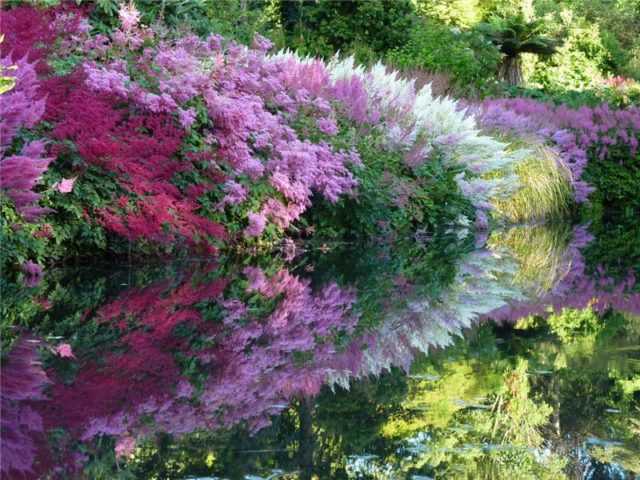
When choosing a plant, you need to immediately plan where it will grow.
It is important to select astilba according to the flowering time. It depends on the neighbors of the plant whether to give preference to an early or late variety. The best option for a garden is continuous flowering flower beds, where perennials bloom alternately.
Conclusion
Varieties and types of astilbe with photos and names is a very exciting topic for study. The plant can decorate any corner of the garden, if you pick it up taking into account the height, the shade of the inflorescences and the timing of flowering.
